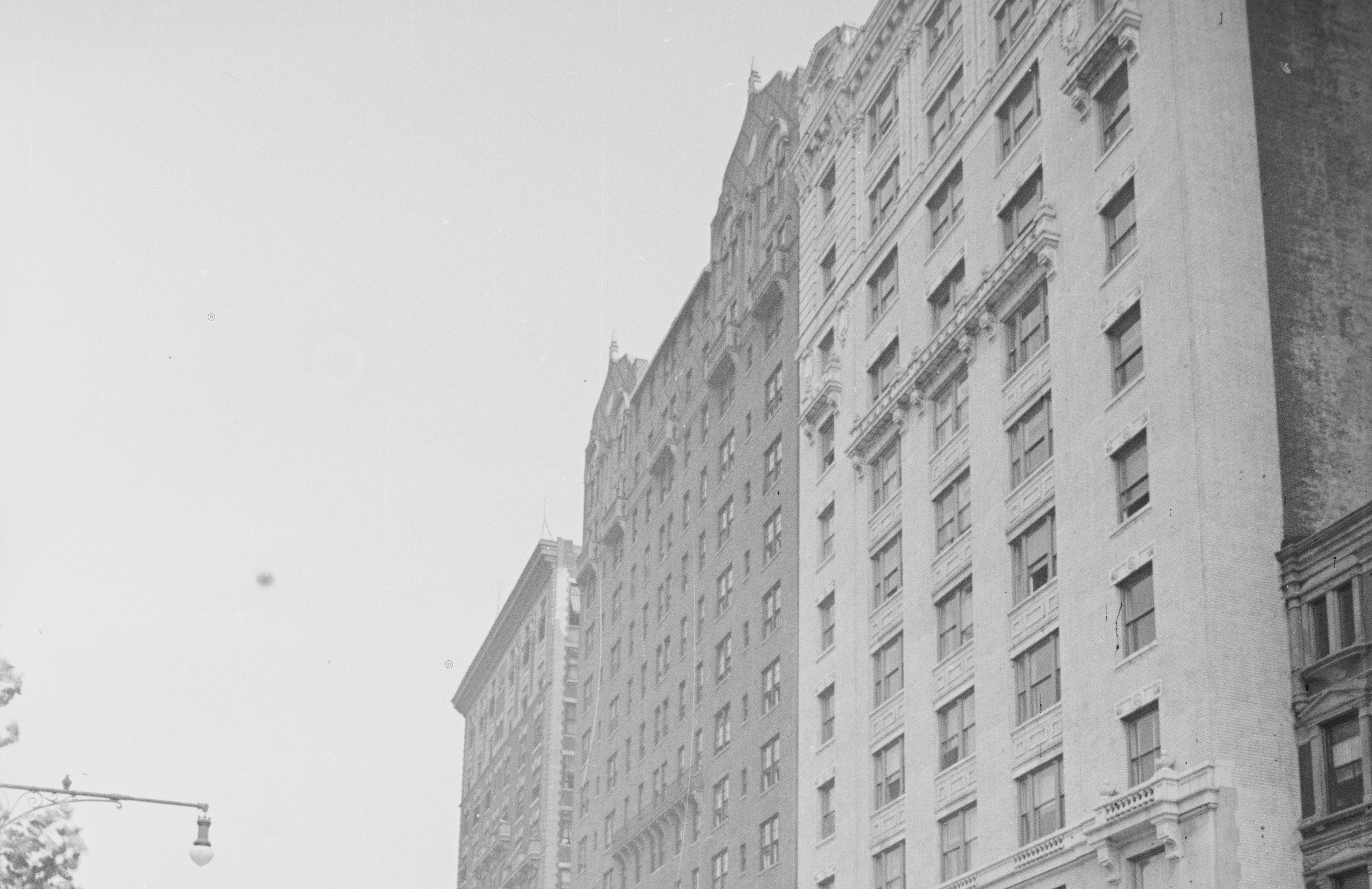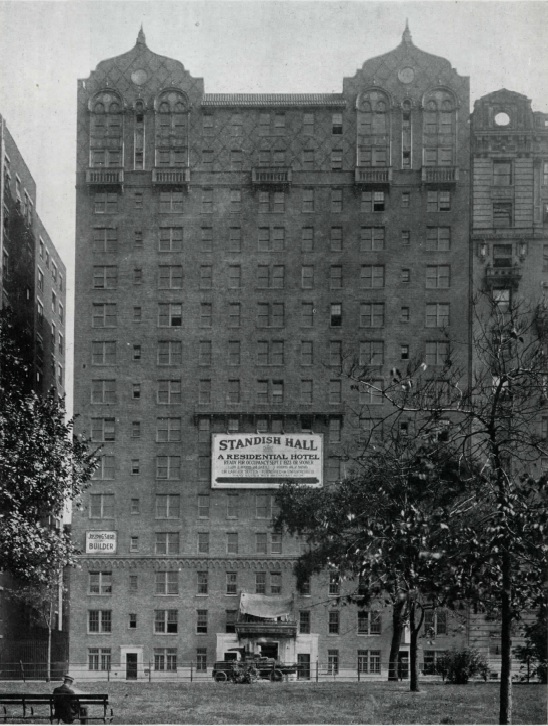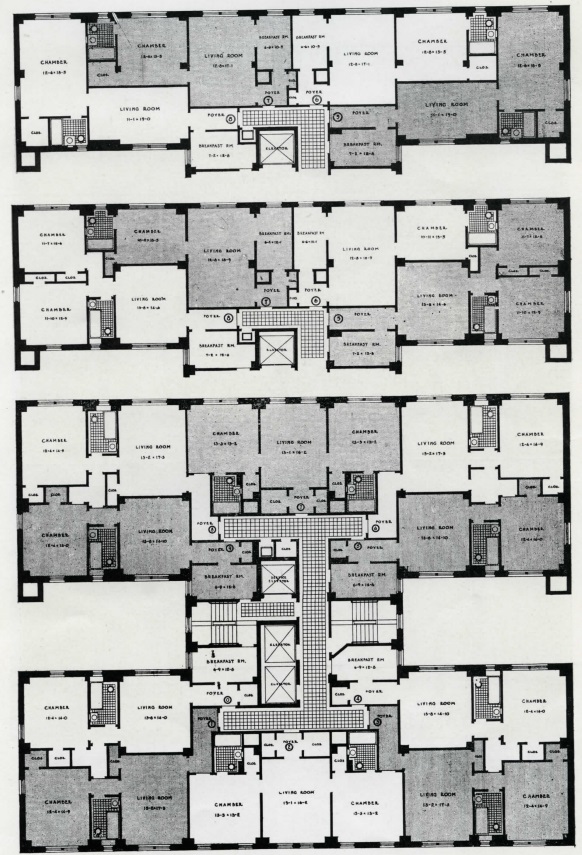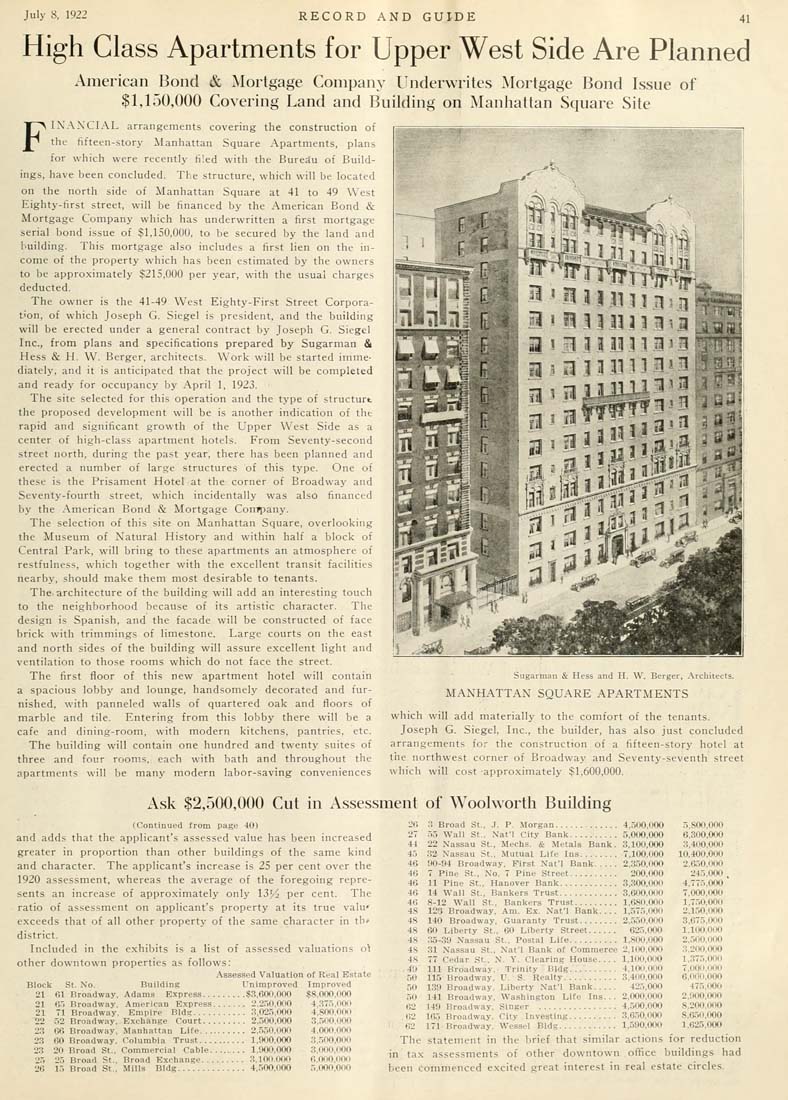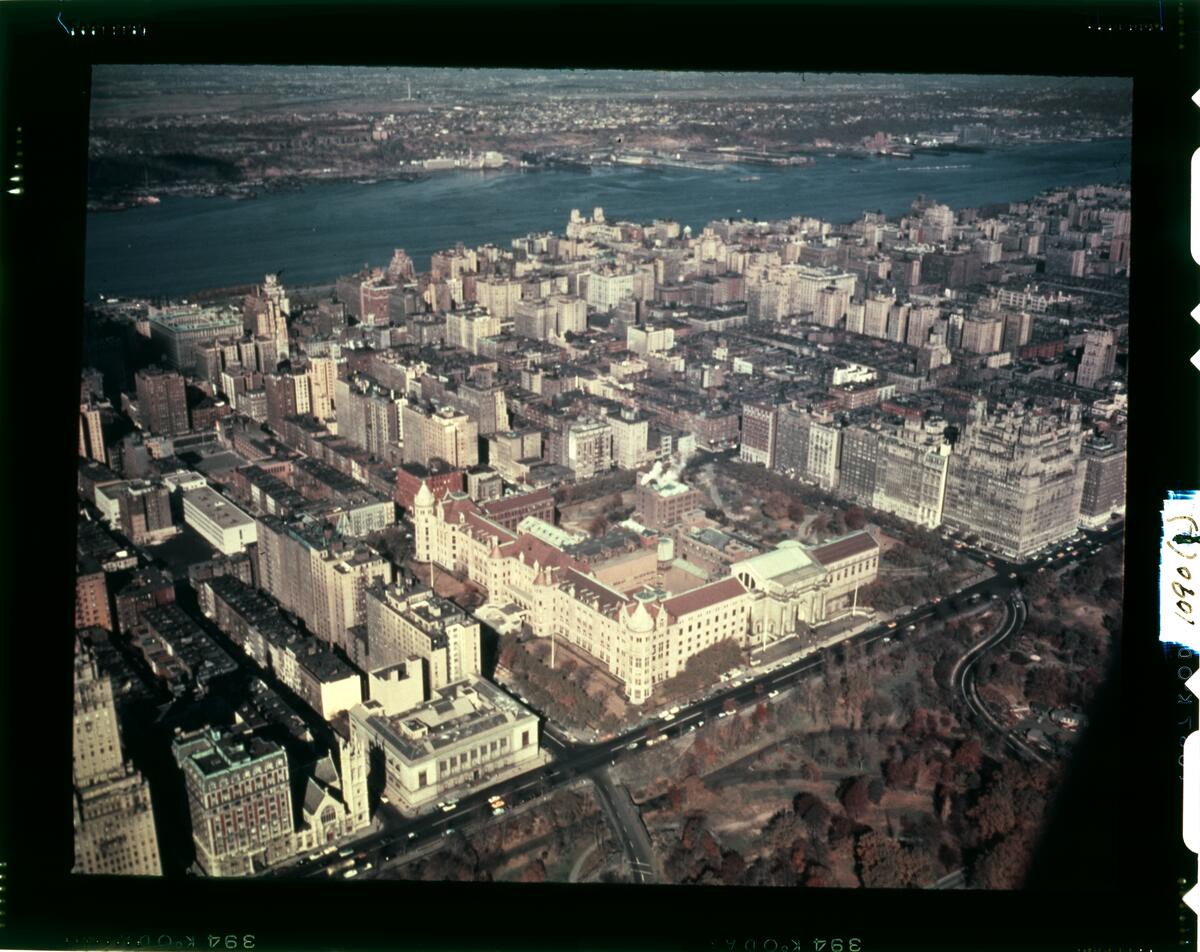
45 West 81st Street: Hotel Standish Hall
by Megan Fitzpatrick
In the early 20th century the north side of West 81st Street was a popular location for the construction of luxury apartments that had an unobstructed view of the American Museum of Natural History on Manhattan Square. The Hotel Standish Hall at 45 West 81st Street was one of the earliest apartments that went up in 1922. Designed by the architectural collaboration of Sugarman, Hess, and Berger, the elaborately decorated building stands out even in the eclectic neighborhood of the Upper West Side. Often described as ‘Spanish Renaissance’, its style can also be described as neo-Moorish, featuring Islamic-inspired ornamentation. This buff brick tripartite building exhibits band courses trimmed with terra cotta. The uppermost section has characteristic geometric patterns in brick, bookended with ogee-shaped arches above the roofline and a highly ornamented limestone door enframement at the bottom.
Prior to the Hotel Standish Hall sat five rowhouses from 41-49 West 81st Street owned by Marshall Roberts. Reported in the Real Estate Record and Guide in 1922, the plot “125×100 ft. on the northside of West 81st Street” was purchased by real estate developers I. Randolph and Everett Jacobs (Feb. 18, 1992A, p. 204). It continues that the property was in the hands of the seller for more than fifty years, and was vacant at the time of sale. We do know that the Hamilton Institute, a preparatory school, was located at 45 West 81st Street until sometime around 1918 (New York Times, Sept. 09, 1897, p. 11). The Guide also notes the sale of the property eliminated existing restrictions to build. In order to make the plot available and lift restrictions, the owners were obliged to buy the houses that abutted the rear, 62-74 West 82nd, which went back on the market shortly after.
Often described as ‘Spanish Renaissance’, its style can also be described as neo-Moorish, featuring Islamic-inspired ornamentation.
Just four short months later the Jacobs brothers sold the same plot “opposite Manhattan Park” to active developer Joseph G. Siegal it was announced on May 27, 1922, with the plan to erect a 15-story apartment hotel. At the same time, Siegal was erecting another 25-story hotel on the northeast corner of Broadway and 74th Street, also designed by Sugarman and Hess (Real Estate Record and Guide, May 27, 1922A, p. 652). The firm of Sugarman, Hess & Berger constructed approximately nine buildings in this district – many on 86th Street and frequently in the neo-Renaissance style. Their partnership was flexible and would often involve Sugarman working with Hess and Berger separately.
Named the Hotel Standish Hall, apparently after Myles Standish – the captain of the Mayflower, its construction began immediately in July 1922 at the cost of $1,500,000. The plans included a 15-story structure originally built with 120 three and four-room suites. The area around Manhattan Square became prime real estate with high-rise apartments quickly going up in the 1920s. The Real Estate Record and Guide reported the apartments in the hotel promoted many “modern labor-saving conveniences” with such comforts as modern kitchens, pantries and, a cafe and lounge in the hotel’s lobby (July 08, 1922B, p. 41).
The hotel met a string of difficulties just ten years after it had opened. This hotel in such a favorable location was experiencing low occupancy and running a deficit during 1933-35. The owners pinned the reasoning on outdated furnishing, equipment, and infrastructure that hadn’t been updated in over 10 years. Therefore, the hotel underwent a complete renovation of the interior to update how it looked and functioned. This involved refurnishing an expanded number of suites – approximately 331 – the installation of Venetian blinds throughout, painting the exterior and interior, installing a rooftop garden, and remodeling the dining room. In an effort to update the comfortability of the apartments, air conditioning was installed as were electric fridges and stoves (New York Times, Oct. 10, 1937, p. 198).
The hotel’s functional misfortunes would continue when in June of 1951, the Local 144 branch of the AFL Hotel Front Service Employees Union organized a strike of hotel bellhops, doormen, and elevator operators. The dispute began over wages. The typical rate at the time was $1.75 a week, the union sought to boost that to $4 a week. Approximately 800 union members walked off the job on the day of the strike 1 June, 1951 with over 2,000 members in the union threatening the stability of the hotel industry. Many hotels, including the Hotel Standish Hall, threatened to lock the workers out if the strike continued. Unfortunately, the paper trail on this story ran out and the result of the strike and potential lockout is unknown (Daily News, June 02, 1951, p. 158).
Many hotels, including the Hotel Standish Hall, threatened to lock the workers out if the strike continued
It was around this time that the hotel was bought by a new owner, Irving Maidman, who sought to modernize the hotel further, starting with a name change – The Excelsior Hotel. Maidman was a first-generation American, to Russian parents who gained success in real estate, mostly with theaters. From the 1940s onwards he was one of the most active real estate developers in the city (New York Times, Oct. 08, 1979, p. 33). During this period the hotel was predominantly Russian-occupied. More than 200 Russian nationals were employed in the UN Secretariat since the UN adopted Russian as an official language in 1946, many of whom gravitated towards this hotel and established a virtual Russian community there.
The hotel was embroiled in an international spy scandal in February, 1970 when Aleksandr V. Tikhomirov was arrested and identified as an alleged spy by FBI Director J. Edgar Hoover. His arrest over an alleged conspiracy to commit espionage by obtaining secrets with the intent to be used by the Soviet Union was the biggest case involving the US-Soviet foreign relations in six years. Tikhomirov lived with his wife, Inna, and daughter, Elena, at the Excelsior Hotel. They paid $300 (over $2,000 today) for a three-room apartment on the 16th floor. His wife, who also worked at the UN Secretariat, locked herself and her daughter in their apartment upon hearing of her husband’s arrest and refused to speak to the press (Daily News, Feb. 08, 1970, p. 2).
The Excelsior, maintaining its neo-Moorish features, was sold in 2021 and will be turned into high-end residential apartments.
Megan Fitzpatrick is the Preservation Director of LANDMARK WEST!
Building Database


